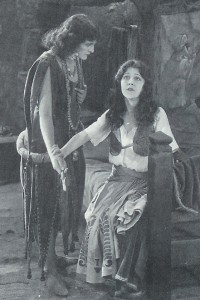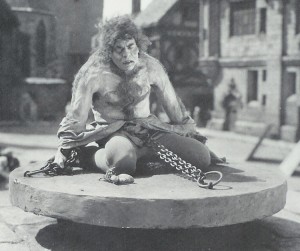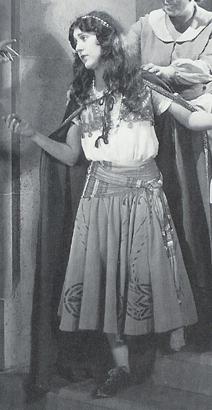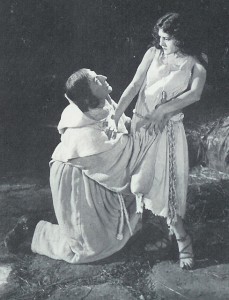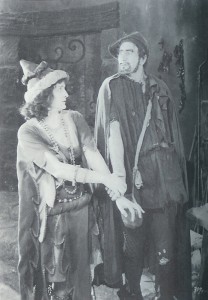The Costumes in the 1923 version of Hunchback are for the most part good. They look appropriate to fashions of the late middle ages. However with the exceptions of Chaney’s make-up for Quasimodo the costumes are not spectacular. There is no one costume that stands out and is memorable. They are just nice and appropriate to both the characters and the times. However there are two costumes I would like to discuss in addition to Chaney’s make-up since Chaney is the main selling point of the film.
Lon Chaney was a genius with make-up. It’s not wonder that he has been dubbed the “Man of a Thousand Faces.” His most memorable transformations of his own face in his film career were the Phantom and Quasimodo.
For Quasimodo, Chaney looked at illustrations by Hugo to get an accurate look. For his cheeks Chaney used cotton and colodium. Colodium is a skin sealer. What he would do is paint spirit gum, which is an adhesive, apply a wad of cotton to it and then cover it with colodium. The process was repeated to build up the cheeks to the desire look. This also allowed Chaney to reuse the cheeks for a few day with minimal effort. For the hunch he wore a 15-20 pound plaster hump. The hump was held in place by a leather harness that attract at the waist. It also had straps at the shoulders that attached to the belt to keep Chaney in a hunch position.
He also wore a rubber suit over the harness in the pillory scene. He covered it with hair to give Quasimodo an animal-like look. Early in the film he had hair on his knuckles but he did away with that as the filming went one. Chaney also employed false teeth and a wig.
I don’t think the Quasimodo’s look has aged as well as the Phantom’s make-up but Chaney did help solidify movie make-up and set a precedent for the look of future Quasimodos so I do give kudos to the make-up in this version.
So there are a few costumes I want to discuss, three of Esmeralda’s and Marie’s costumes. Esmeralda has four costume changes but I want to look at three, her normal outfit, prison dress and her robe. The Costumes were supervised by Gordon Magee, that they only costume credit I found.
Esmeralda’s normal gypsy costume is based on a 1891 illustration. You can see it in the vest, short sleeves, the shoes and the mid calf hem line. While I like this costume as a whole it is inaccurate to the Romani convention that ankles should not be expose but their is another force at work in Esmeralda’s costume; the 1920’s.
Esmeralda’s costume has a more shapeless silhouette, long beaded necklaces and the sleeves look straighter and look more like modern t-shirt.
However Esmeralda’s prison dress and her robe look more like a product of the 20’s. Her prison dress has a shapeless silhouette and the way it cinches in at the waist and puffs over is very 20s. Plus the short hemline. Hemlines that hit mid-calf was the style in 1923 for hem.
However the robe is the worse offender of Esmeralda’s costumes. In a deleted scene from the movie, Quasimodo trades candles for clothing for Esmeralda to wear. He gets a robe or a “dressing gown” that has a fur trim and looks to be made of velvet with a satin belt.
Number 1; robes didn’t not exist at this time in Europe.. Robe/dressing gown came in to fashion in the 18th century because orientism was fashionable. Number 2; given the materials, fur, satin and velvet, it’s doubtful that a mere chest of candles could be traded for a garment made from these materials. Beside those issues, the robe features the signature 1923 hemline and the shoes. The shoes that Esmeralda wears with the robe are flats with a flower detail. Clearly not shoes wore in the middle ages.
However the worse offender of the 1920 style in a costume is Marie’s. Marie is Clopin’s wife. Marie actually has two costumes but they’re very similar. Both are very shapeless dresses that flattened out her chest which is the classic 1920 silhouette.
One has almost kimono-esque sleeves that have a scallops detail at the edge. Both hemlines hit at the ankles but one it’s a handkerchief hem, so the longest point hit the ankle.
Handkerchief hems were popular in the 1910-1920’s and it was seen in Ancient Greece. While it was used in Antiquity it was not at all popular in 1482. The other one is pointed with a scallop edge which makes it appear shorter. While Esmeralda’s costumes harken to the 20’s, Marie’s flaunts it to the point that it looks really out of place.
The costumes are appropriately medieval for the men and the women’s costumes are mixed with the style of the 1920 to make they look more stylish regardless of period appropriateness.
Pictures came from the Philip J Riley Book
Next Time – The Sets
Follow thehunchblog
